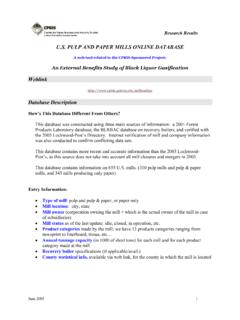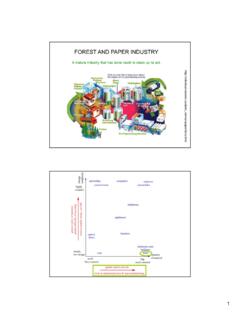Transcription of THE PULP AND PAPER INDUSTRY IN BRAZIL
1 14 Guia ABTCPFORNECEDORES&FABRICANTES celulose e papel 2015|2016 Current Situation2015 has proven to be an agitated year. Abroad, the world faces a new order dictated by low oil prices (at least for now) and by the European Union and its economic recovery process threatened by new developments in the Greek crisis. On top of this, there s the slowdown in China s growth and a worrisome environment in the Middle East and Eastern situation impacts BRAZIL in two different, but interconnected, ways: in the domestic market, it affects PAPER production; globally, it directly affects pulp production for export, which has been the sector s main driver of growth.
2 The global PAPER market has been mainly influenced over the last decade by three key factors: globalization in terms of consumption habits and greater permeability in international trade; the dematerialization of information means, given the progress of digital media; and the increase in purchasing power on the part of large masses of population residing in developing countries and the resulting ascension to a new middle class with more sophisticated and demanding landscape has catalyzed the development of the following trends: growing importance of the Asian region as a big PAPER producer and consumer; accelerated advancement of electronic information transmission and disclosure technologies; slow and bumpy recovery of the European Union.
3 United States economic recovery based on innovation and disruptive technologies, such as shale gas; and changes in the political scenario, such as the suspension of sanctions on Cuba and pulp AND PAPER INDUSTRY IN BRAZIL By:Carlos Alberto Farinha e Silva vice-president of P yry Tecnologia Mendes Bueno director of P yry Management Consulting Latin AmericaManoel Rodrigues Neves manager of Economic Studies at P yry Tecnologia in BrazilBrief historyThe history of BRAZIL s silviculture is intimately associated to the development of the country s forest base INDUSTRY .
4 At the end of the 1950s, the government s planning effort to promote economic development was materialized in a Plan of Targets, which listed five priority areas for earmarking investments and established objectives to be achieved in five years. The pulp and PAPER INDUSTRY was one of the sectors contemplated in the Plan. The annual production target was set at 200 thousand tons of pulp and 450 thousand tons of PAPER , which included 130 thousand tons of newsprint. As a result, the National Bank of Economic and Social Development (BNDES), despite not having given special priority to the sector, began supporting it more constantly as of 1957, including through several emblematic projects involving eucalyptus pulp government s second movement that leveraged BRAZIL s forest If you don t like something, change it.
5 If you can t change it, change your attitude. Maya Angelou (Marguerite Ann Johnson) 1928-2014 American writer, poetess and civil rights activist1 Forest Plantations15celulose e papel 2015|2016 Guia ABTCPFORNECEDORES&FABRICANTES base was a 1966 tax incentive policy (Law #5,106), which, by allowing to deduct from income taxes investments in forest plantations, allowed for the creation of BRAZIL s forest base, which was to first supply the steel INDUSTRY with coal and the pulp INDUSTRY with a result of the tax incentive program, between 1965 and 1985, the area of forest plantations in BRAZIL , especially of Eucalyptus and Pinus, jumped from 500 thousand to approximately million hectares distributed in the so-called forest districts.
6 Target regions for the forest base INDUSTRY . The learning curve during these 20 years was long and arduous, especially in the silviculture, management and genetics areas. To support development of silviculture, the federal government created autarchies: the Brazilian Institute of Forestry Development (IBDF), with the mission of planning and coordinating the forestry policy, and the National Center of Forest Research (CNPF), within the Brazilian Agribusiness Research Company (Embrapa), with the objective of developing technologies for implementing and managing forest plantations reached a significant amount of area and began producing, the consolidation phase of BRAZIL s forestry business kicked off.
7 During this period, with the technological development of silviculture, management and genetics, it was possible to increase average productivity of Eucalyptus plantations from 15 to 43 m /ha per year. In relation to Pinus History Development of the Eucalyptus ProductivityPulp and PAPER Reconstituted Panels16 Guia ABTCPFORNECEDORES&FABRICANTES celulose e papel 2015|2016plantations, managed for multiple products, annual productivity grew from 15 to 32 m /ha. In the case of managed plantations for producing fine wood, productivity increased from 15 to roughly 40 m during the maturation phase of BRAZIL s forestry business, rapid expansion and diversification of the forest base INDUSTRY was observed, such as the growth of pulp / PAPER and coal-based steel industries, as well as the development of reconstituted panels INDUSTRY .
8 Additionally, the production of sawn and laminated timber from planted forests substituted the use of wood from native forests. In the beginning of the 2000 decade, the forest base INDUSTRY faced socioenvironmental forces, a phenomenon that surfaced in the early 1970s and consolidated in the 2000s, questioning its development model. In response, the INDUSTRY made a significant effort towards socioenvironmental sustainability, leading the sector to certify practically all its forest shown in Figure 1, between 2004 and 2014, BRAZIL s forest base INDUSTRY became a highly competitive world-class business in the international market, mainly due to the high productivity of its planted forests.
9 During the period, planted areas grew at an average rate of 7% a year. Silviculture adapted to new frontiers in the midwest and north regions of the country, due to the limited availability of land for expanding the planted area in traditional clusters along the coastal region. Maturity of the forestry business attracted international investors with a focus on the pulp and reconstituted panels INDUSTRY , as well as silviculture. In the case of silviculture, Timber Investment Management Organizations (TIMOS) became an important lever for the growth of BRAZIL s planted area, also contributing to the important shift from the integrated model (forest- INDUSTRY ) to a market model ( INDUSTRY -tree growers).
10 Without a doubt, forestry development programs also contributed significantly to this the pursuit of greater profitability in the activity, a significant technological advancement also occurred in biotechnology, with the development of clones that were more productive and resistant to diseases/pests; in silviculture and harvesting processes, with intensive mechanization; and in information technology and management processes. Progress was also observed in the development of new industrial processes and products with the more recent arrival of the biorefinery concept.


















